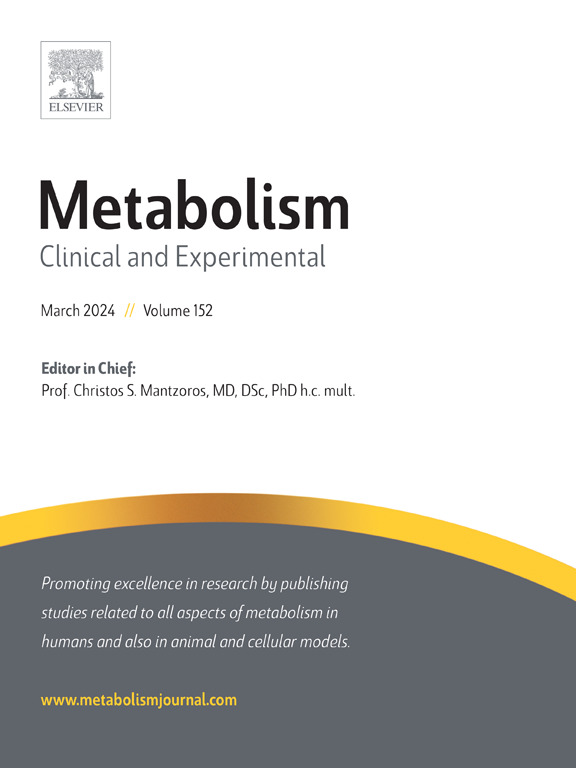植物乳杆菌菌株84-3衍生的l-谷氨酰胺通过激活AMPK/PPARγ信号通路改善2型糖尿病患者的葡萄糖稳态
IF 11.9
1区 医学
Q1 ENDOCRINOLOGY & METABOLISM
引用次数: 0
摘要
背景:肠道菌群及其代谢产物在2型糖尿病(T2D)中起重要作用。然而,个别菌株及其代谢物对T2D发病机制的贡献仍然知之甚少。我们在各种动物模型中研究乳酸杆菌对T2D的调节,以了解其治疗作用。方法和结果:我们对中国成年人进行了一项病例对照研究,使用代谢组分析发现l-谷氨酰胺与T2D血清浓度呈负相关。同时还鉴定出了植物L. 84-3中编码谷氨酰胺合成酶(GS)的glnA和GLUL基因。L. plantarum 84-3治疗显著降低了链脲佐菌素或四氧嘧啶诱导的T2D大鼠的血清炎症,改善了代谢表型,包括血糖、葡萄糖耐量、胰岛素抵抗和血脂。我们证实84-3植物乳杆菌组血清l-谷氨酰胺水平升高。RNA测序分析表明,L. plantarum 84-3衍生的l-谷氨酰胺是一种重要的生物活性分子,通过激活肝脏AMPK/PPAR信号通路和改善T2D来改善葡萄糖稳态。我们进行了体外和体内共培养发酵实验,元基因组学和代谢组学分析显示,抗性淀粉与L. plantarum 84-3结合后显著增加了乳酸杆菌的丰度,提高了l-谷氨酰胺水平,影响了丙氨酸、天冬氨酸和谷氨酸的代谢途径,这在大鼠体内得到了证实。降低的植物乳杆菌和l-谷氨酰胺水平在人类T2D队列中得到验证。结论:这些发现揭示了植物乳草通过增加循环l-谷氨酰胺来缓解t2d相关葡萄糖稳态的新作用,为代谢紊乱的预防和治疗提供了可行的策略。本文章由计算机程序翻译,如有差异,请以英文原文为准。

Lactiplantibacillus plantarum strain 84-3-derived l-glutamine ameliorates glucose homeostasis via AMPK/PPARγ signaling pathway activation in type 2 diabetes
Background
Gut microbiota and their metabolites play an essential role in type 2 diabetes (T2D). However, contributions of individual bacterial strains and their metabolites to T2D pathogenesis remain poorly understood. We investigated T2D regulation by Lactobacillus in various animal models to understand its therapeutic effects.
Methods and results
We performed a case-control study of Chinese adults using metabolome profiling and identified an inverse correlation between l-glutamine and T2D serum concentrations. The glnA and GLUL genes encoding glutamine synthetase (GS) in L. plantarum 84–3 were also identified. L. plantarum 84–3 treatment significantly decreased serum inflammation and improved metabolic phenotypes in streptozotocin- or tetraoxypyrimidine-induced T2D rats, including blood glucose, glucose tolerance, insulin resistance, and lipids. We confirmed elevated serum l-glutamine levels in the L. plantarum 84–3 group. RNA sequencing analysis demonstrated that L. plantarum 84–3-derived l-glutamine is a vital bioactive molecule, improving glucose homeostasis by activating the liver AMPK/PPAR signaling pathway and ameliorating T2D. We conducted co-culture fermentation experiments in vitro and in vivo, and metagenomic and metabolomic analyses revealed that resistance starch combined with L. plantarum 84–3 significantly enriched of Lactobacillus abundance and increased the l-glutamine level, affecting of alanine, aspartate, and glutamate metabolism pathways, which was confirmed in vivo in rats. The reduced L. plantarum and l-glutamine levels were validated in a human T2D cohort.
Conclusions
These findings revealed a novel therapeutic effect of L. plantarum in alleviating T2D-related glucose homeostasis by increasing circulating l-glutamine, which suggests viable preventive and therapeutic strategies for metabolic disorders.
求助全文
通过发布文献求助,成功后即可免费获取论文全文。
去求助
来源期刊

Metabolism: clinical and experimental
医学-内分泌学与代谢
CiteScore
18.90
自引率
3.10%
发文量
310
审稿时长
16 days
期刊介绍:
Metabolism upholds research excellence by disseminating high-quality original research, reviews, editorials, and commentaries covering all facets of human metabolism.
Consideration for publication in Metabolism extends to studies in humans, animal, and cellular models, with a particular emphasis on work demonstrating strong translational potential.
The journal addresses a range of topics, including:
- Energy Expenditure and Obesity
- Metabolic Syndrome, Prediabetes, and Diabetes
- Nutrition, Exercise, and the Environment
- Genetics and Genomics, Proteomics, and Metabolomics
- Carbohydrate, Lipid, and Protein Metabolism
- Endocrinology and Hypertension
- Mineral and Bone Metabolism
- Cardiovascular Diseases and Malignancies
- Inflammation in metabolism and immunometabolism
 求助内容:
求助内容: 应助结果提醒方式:
应助结果提醒方式:


